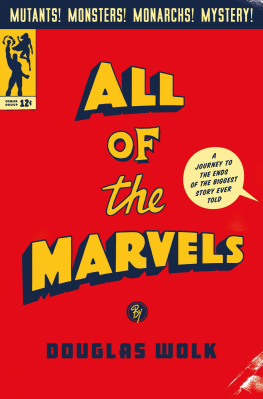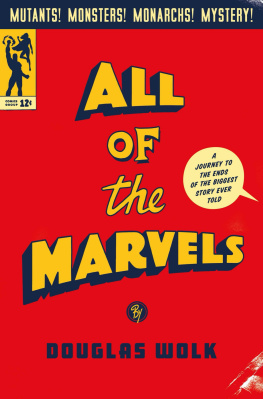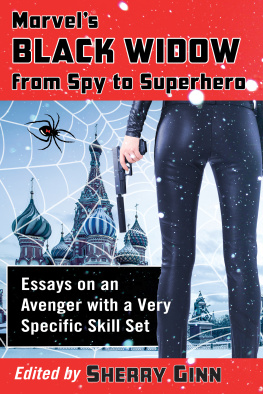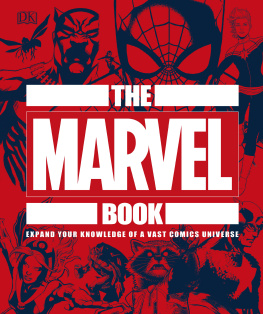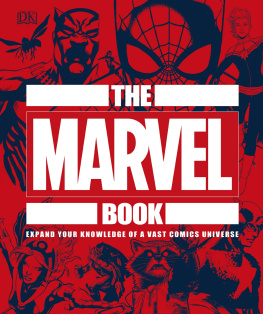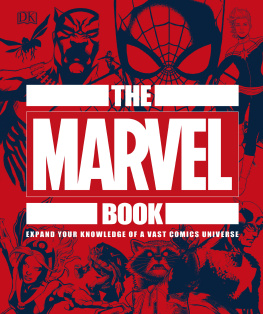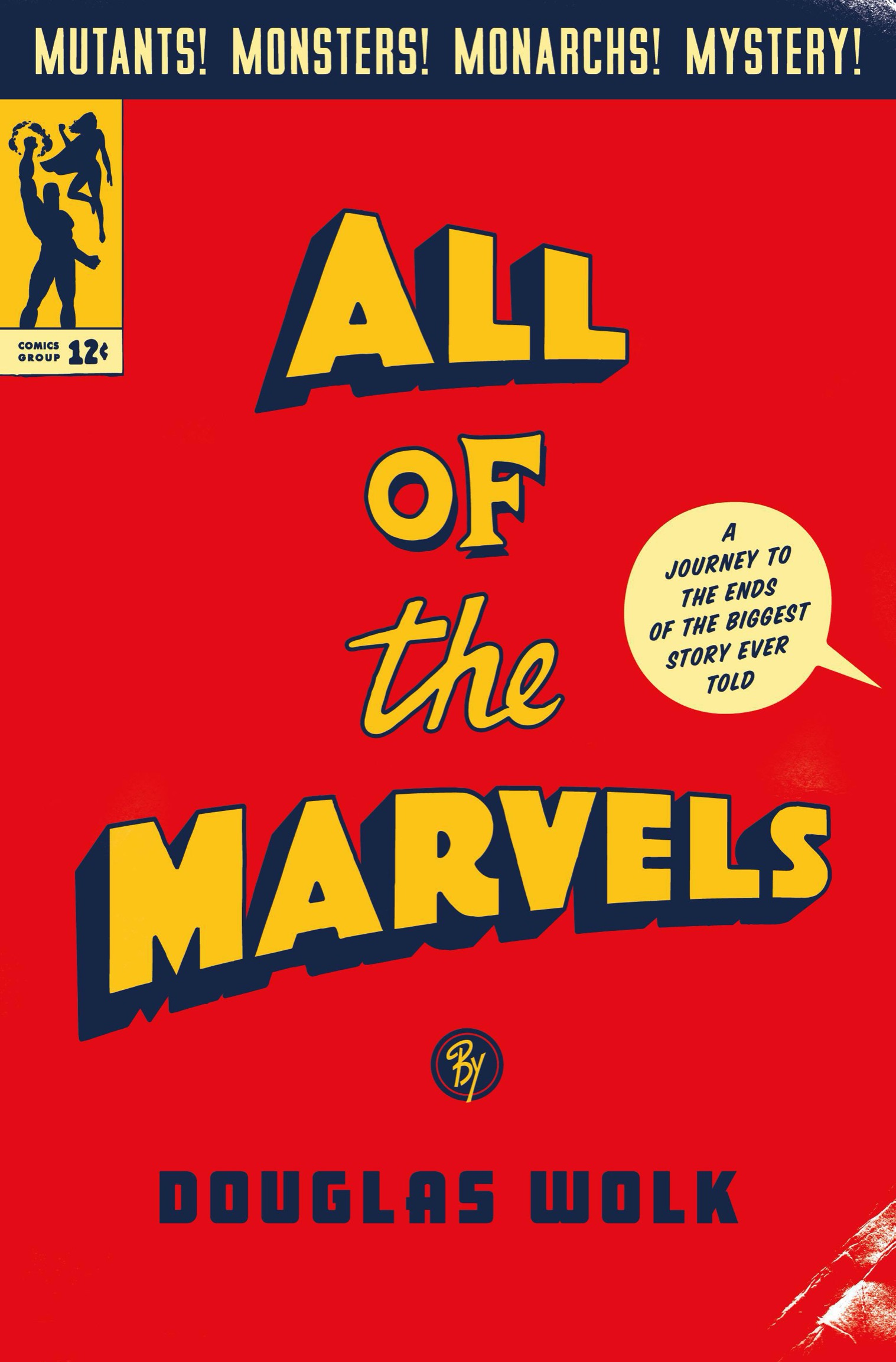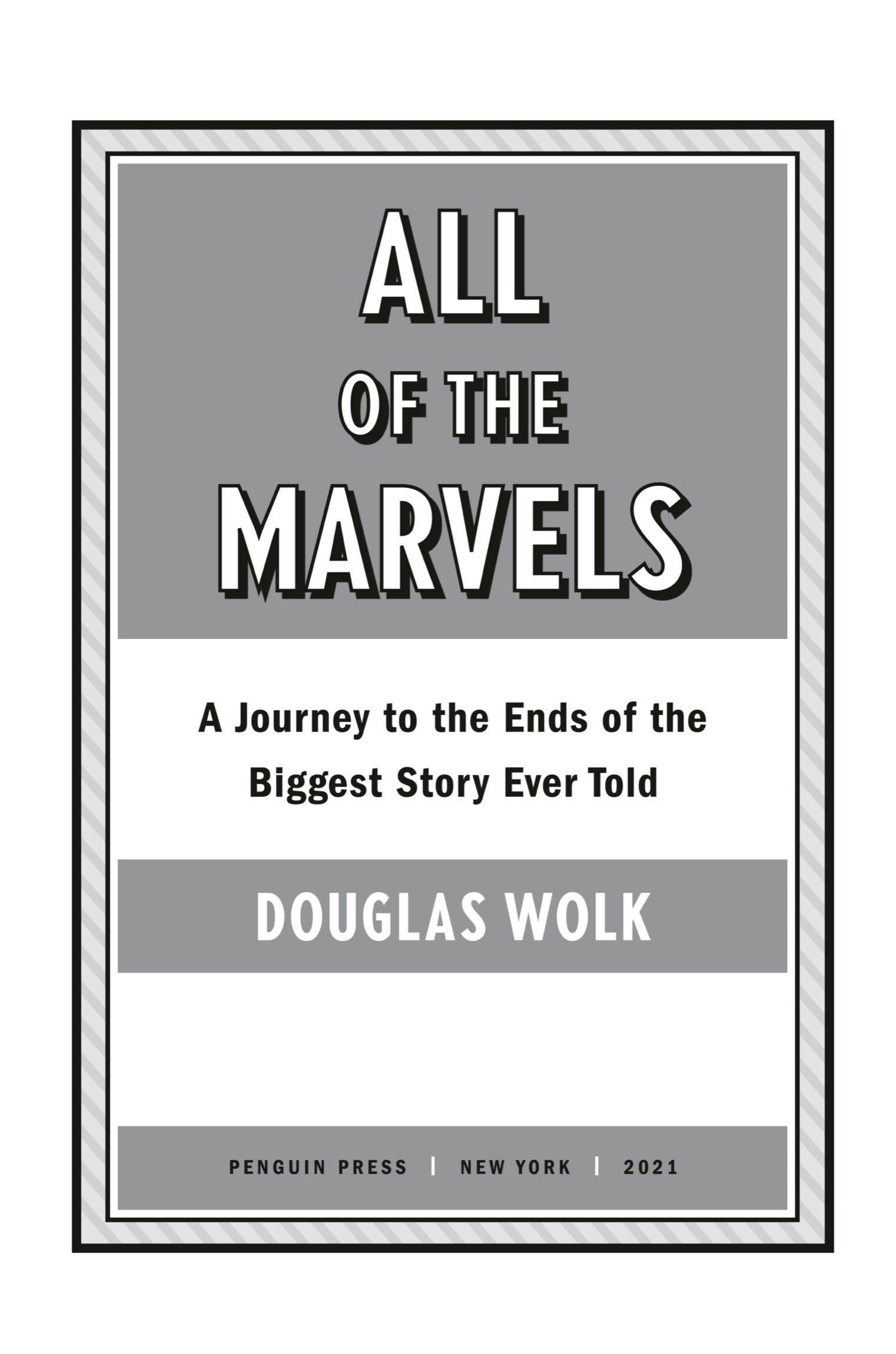ALSO BY DOUGLAS WOLK
James Browns Live at the Apollo
Reading Comics: How Graphic Novels Work and What They Mean
PENGUIN PRESS
An imprint of Penguin Random House LLC
penguinrandomhouse.com
Copyright 2021 by Douglas Wolk
Penguin supports copyright. Copyright fuels creativity, encourages diverse voices, promotes free speech, and creates a vibrant culture. Thank you for buying an authorized edition of this book and for complying with copyright laws by not reproducing, scanning, or distributing any part of it in any form without permission. You are supporting writers and allowing Penguin to continue to publish books for every reader.
library of congress cataloging-in-publication data
Names: Wolk, Douglas, author.
Title: All of the marvels : a journey to the ends of the biggest story ever told / Douglas Wolk.
Description: New York : Penguin Press, 2021. | Includes bibliographical references and index.
Identifiers: LCCN 2021013414 (print) | LCCN 2021013415 (ebook) | ISBN 9780735222168 (hardcover) | ISBN 9780593300596 (international edition) | ISBN 9780735222175 (ebook)
Subjects: LCSH: Marvel Comics GroupHistory. | Comic books, strips, etc.United StatesHistory and criticism. | Comic books, strips, etcPublishingUnited StatesHistory. | Literature and societyUnited StatesHistory.
Classification: LCC PN6725 .W64 2021 (print) | LCC PN6725 (ebook) | DDC 741.5/973dc23
LC record available at https://lccn.loc.gov/2021013414
LC ebook record available at https://lccn.loc.gov/2021013415
Designed by Meighan Cavanaugh, adapted for ebook by Shayan Saalabi
This book is not sponsored or endorsed by Marvel Worldwide Inc. or any of its affiliates, divisions, subsidiaries or parent companies.
pid_prh_5.8.0_c0_r0
For Sterling, who read with me
Ink runs from the corners of my mouth.
There is no happiness like mine
Mark Strand, Eating Poetry
The story of Doom can end, you say?... Then Im a better story than you.
Doctor Doom, to Loki, in Loki: Agent of Asgard #6
Contents
1
THE MOUNTAIN OF MARVELS
The twenty-seven thousand or so superhero comic books that Marvel Comics has published since 1961 are the longest continuous, self-contained work of fiction ever created: over half a million pages to date, and growing. Thousands of writers and artists have contributed to it. Every week, about twenty slim pamphlets of twenty or thirty pages apiece are added to the body of its single enormous story. By design, any of its episodes can build on the events of any that came before it, and theyre all (more or less) consistent with one another.
Every schoolchild recognizes the Marvel storys protagonists: Spider-Man, the Incredible Hulk, the X-Men. Eighteen of the hundred highest-grossing movies of all time, from Avengers: Endgame and Black Panther down to Captain America: The Winter Soldier and Guardians of the Galaxy, are based on parts of the story, and it has profoundly influenced a lot of the rest: Star Wars and Avatar and The Matrix would be unimaginable without it.
Its characters and the images associated with them appear on T-shirts, travel pillows, dog leashes, pizza cutters, shampoo bottles, fishing gear, jigsaw puzzles, and bags of salad greens. (Some of the people who love the story also love to be reminded of it, or to associate themselves with particular characters from it.) Its catchphrases have seeped into standard usage: Spidey-sense, you wouldnt like me when Im angry, I say thee nay, healing factor, noyou move, bitten by a radioactive spider, puny humans, threat or menace?, true believers, nuff said. Parts of it have been adapted into serial TV dramas, animated cartoons, prose novels, picture books, video games, theme-park attractions, and a Broadway musical. For someone who lives in our society, having some familiarity with the Marvel story is useful in much the same way as, say, being familiar with the Bible is useful for someone who lives in a Judeo-Christian society: its iconography and influence are pervasive.
The Marvel story is a mountain, smack in the middle of contemporary culture. The mountain wasnt always there. At first, there was a little subterranean wonder in that spot, a cave that was rumored to have monsters inside it; colorful adventurers had once tested their skills there, and lovers met at its mouth. Then, in the 1960s, it started bulging up above the surface of the earth, and it never stopped growing.
Its not the kind of mountain whose face you can climb. It doesnt seem hazardous (and it isnt), but those who try to follow what appear to be direct trails to its summit find that its grown higher every time they look up. The way to experience what the mountain has to offer is to go inside it and explore its innumerable bioluminescent caverns and twisty passageways; some of them lead to stunning vantage points onto the landscape that surrounds it.
There is no clear pathway into the mountain from the outside. Parts of it are abandoned and choked with cobwebs. Other parts are tedious, gruesome, ludicrous, infuriating. And yet people emerge from it all the time, gasping and cheering, telling one another about the marvels theyve seen, then rushing back in for more.
/////
Marvel Comics, as an artistic and commercial project, began in the early 1960s, initially as the work of a handful of experienced comics professionalsartists Jack Kirby and Steve Ditko, editor/writer Stan Lee, and a few others. The superhero stories that had dominated American comic books in the late 30s and early 40s had mostly fallen out of style at that point, but instead of returning to that faltering genre as it had been, Kirby, Ditko, and Lee combined it with aspects of the genres that had supplanted it: the uncanny horror of the monster and sci-fi stories Ditko and Kirby had been drawing more recently; the focus on the emotion of the romance anthologies Kirby had helped to invent in 1947; the gently jabbing wit of the humor titles Lee had been writing for many years. That hybrid formulaabsorbing monster comics and romance comics and humor comics into superhero comicsturned out to be irresistible and durable. Marvels early stories responded to the atmosphere of their historical moment, sometimes explicitly in their content and always implicitly in their themes.
Then Kirby, Lee, Ditko, and their collaborators figured out how to make the individual narrative melodies of all of their comics harmonize with one another, turning each episode into a component of a gigantic epic. That led to a vastly broader artistic collaboration: ever since then, its writers and artists have been elaborating on one anothers visions, sometimes set in the same place and time but often separated by generations and continents.
The big Marvel story is a funhouse-mirror history of the past sixty years of American life, from the atomic night-terrors of the Cold War to the technocracy and pluralism of the present daya boisterous, tragicomic, magnificently filigreed story about power and ethics, set in a world transformed by wonders. In some of its deeper caverns, its the most forbidding, baffling, overwhelming work of art in existence. At its fringes, its so easy to understand and enjoy that you can read a five-year-old an issue of The Unbeatable Squirrel Girl

